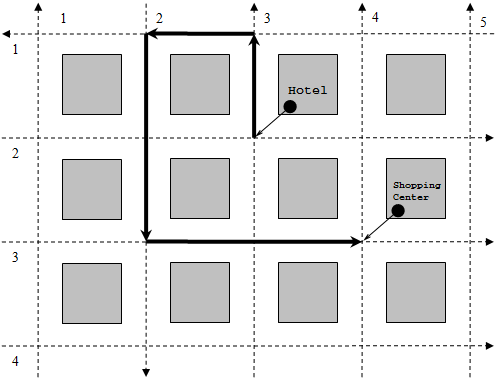NOI '04 P3 - Manhattan
View as PDFNational Olympiad in Informatics, China, 2004
City P is a famous tourist attraction in country M. Under the leadership of Mayor G, the people live and work peacefully in the thriving city. However, Mayor G has not once been carried away by his achievements. His clear head is very aware that there are still some issues that exist in the governance of the city. One of these issues is traffic problems.
City P has

Due to the narrow streets, each street is only one-way. The direction of each street is predetermined. The direction of a horizontal street can only be either east or west. The direction of a vertical street can only be north or south. Going against the designated direction of a street is strictly prohibited.
This limitation is a major inconvenience for traffic. As can be seen in the above figure, tourists may, for example, wish to go from their hotel to the shopping center. However, due to the one-way streets, they have to travel in a big circle to reach their destination.
This problem has been puzzling Mayor G for a while now. Every day, he will receive many letters from tourists, complaining about city P's unreasonable traffic system. Due to the large number of streets, he and his councilmen are still unable to solve this problem.
Fortunately, this problem can soon be resolved. This is because recently, he has paid good money to hire the world-renowned traffic engineer, Mr. B, to renovate city P's traffic system for efficiency.
Mr. B knows that the problem cannot be solved by expanding the width of the streets, since this will impact the various tourist attractions located along each side of the streets. So, he prepares to reassign the directions of some one-way streets to maximize the satisfaction of everyone.
Mr. B assigned labels to each street in city P. The horizontal streets
are labeled with the numbers
After a long period of research, he has assembled some requests made
collectively by tourists. Each request can be written in the following
form: the length of the shortest path from one intersection to another
intersection must be equal to the Manhattan distance between the
intersections. The Manhattan distance between two intersections refers
to the sum of their horizontal and vertical distances. Two
intersections with coordinates
Mr. B already knows the directions of all the streets in city P as well as the requests collectively made by the tourists. Can he reassign the directions of streets to fulfill all of the requests?
Additionally, changing the direction of each street requires a fixed working cost. The size of working costs depend on the streets. Mr. B not only wants to find a valid plan, but he also wants the total working cost of this plan to be minimized. Can you help him?
Input Specification
- The first line of input contains two integers
- The second line of input contains a sequence of characters of length
Esignifies an eastbound street andWsignifies a westbound street. - The third line of input contains a sequence of characters of length
Nsignifies a northbound street andSsignifies a southbound street. - The fourth line contains
- The fourth line contains
- The sixth line contains a single positive integer
- The next
Output Specification
The first line of output should contain one string, either possible
or impossible. Output possible to indicate that
there is a way to reassign directions to streets such that all the
requests in the input are satisfied. Output impossible to indicate
that no matter how directions are reassigned, there is no way to satisfy
all the requests.
If the first output is possible, then the second line should contain
a single integer representing the minimum total working cost, the third
line should contain a string of length E for east, W for west), and the fourth line should contain
a string of length N for north, S
for south).
Constraints
- The working cost to change the direction of any street will not exceed
Sample Input
2 3
WE
NNS
3 9
1 4 2
2
1 3 2 1
2 3 2 2Sample Output
possible
9
WW
NNSScoring
Your score out of 10 for each test case is determined as follows:
- If the first line of your program's output is
impossible:- If there is actually no solution, then you will score full points.
- If there is actually a solution, then you will score 0 points.
- If the first line of your program's output is
possible:- If the remaining lines are incorrectly formatted, your strategy is infeasible, or your total working cost is incorrect in relation to your strategy, then you will score 0 points.
- If your strategy is feasible, but the total working cost is not optimal, then you will score 4 points.
- If your strategy is both feasible and optimal, then you will score full points.
- Otherwise, your score will be 0 points.
Problem translated to English by .
Comments